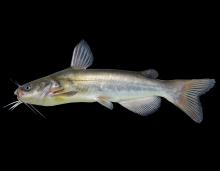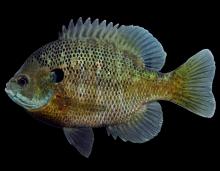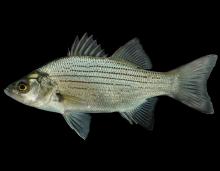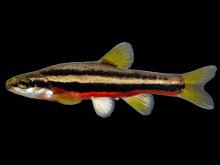Fishes
Media

Species Types
Scientific Name
Ameiurus catus
Description
The white catfish is often stocked in fee-fishing lakes and other private waters. It sometimes escapes into natural stream systems. Unlike our other bullheads, it has a moderately (though not deeply) forked tail fin.
Media

Species Types
Scientific Name
Esox lucius
Description
The largest pike native to Missouri, the northern pike can be more than 4 feet long and weigh more than 40 pounds. Missouri is on the southern edge of the range of this species. Because of its rarity here, it is of little importance as a game fish.
Media

Species Types
Scientific Name
Lepomis cyanellus
Description
The green sunfish is thick-bodied with a large mouth. The upper jaw extends to about the middle of the eye. It may occur in just about any pond, lake, or stream that is capable of supporting fish life.
Media

Species Types
Scientific Name
Lepomis megalotis
Description
The longear sunfish is deep-bodied, slab-sided, with a moderate-sized mouth, the upper jaw nearly reaching the front of the eye. It is by far the most abundant and generally distributed sunfish over the southern half of Missouri.
Media

Species Types
Scientific Name
Lepomis macrochirus
Description
The bluegill is one of the most abundant and popular panfishes in North America. This deep-bodied, slab-sided sunfish sports a black “ear flap” extending from the edge of its gill cover.
Media

Species Types
Scientific Name
Morone chrysops
Description
The white bass is one of the most important game fish in Missouri’s large impoundments. It inhabits the deeper pools of streams and the open water of lakes and reservoirs.
Media

Species Types
Scientific Name
Morone chrysops x M. saxatilis
Description
Hybrids between the striped bass and white bass are stocked by the MDC in select impoundments around the state. Also called "wipers," they attain a larger size than our native white bass.
Media

Species Types
Scientific Name
Notropis, Cyprinella, Hybognathus, Luxilus, and others
Description
Minnows — including shiners, chubs, stonerollers, dace, and carp — are members of the minnow family, the Cyprinidae. It is the largest of all fish families, and Missouri has about 70 species.
Media

Species Types
Scientific Name
Ictalurus punctatus
Description
The channel catfish is the official Missouri state fish. It is pale with dark spots and is found statewide in a variety of habitats, preferring large, rather turbid streams with low or moderate gradients.
See Also


Media

Species Types
Scientific Name
Amphiuma tridactylum
Description
The three-toed amphiuma is an eel-like, completely aquatic salamander. It has very small forelimbs and hind limbs, each with three tiny toes. In Missouri it’s found only in the Bootheel region.
Media

Species Types
Scientific Name
Siren intermedia nettingi
Description
The western lesser siren is an eel-like, aquatic salamander with external gills, small eyes, small forelimbs with four toes, and no hind limbs. In Missouri, it’s found mostly in the Bootheel and northward in counties near the Mississippi River.
About Fishes in Missouri
Missouri has more than 200 kinds of fish, more than are found in most neighboring states. Fishes live in water, breathe with gills, and have fins instead of legs. Most are covered with scales. Most fish in Missouri “look” like fish and could never be confused with anything else. True, lampreys and eels have snakelike bodies — but they also have fins and smooth, slimy skin, which snakes do not.





















